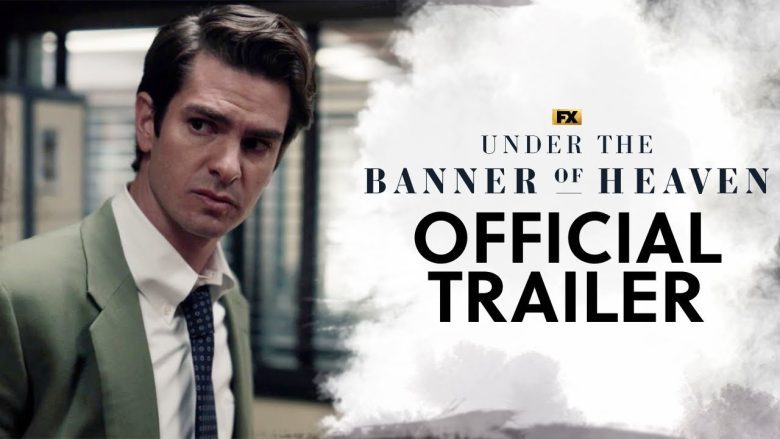UNDER THE BANNER OF HEAVEN – Review by Maureen McCabe Hulu’s seven-part limited series Under the Banner of Heaven, is a sinister, riveting exploration of how religious fervor can become twisted into a dangerous, even murderous, fanaticism, set against the real-life facts of a horrific true crime. Based on John Krakauer’s long, scholarly best-seller of the same name and adapted by Dustin Lance Black, the show is based on two well-publicized murders that took place in Utah in 1984. Brenda Wright Lafferty, a vibrant wife and mother who had just turned 24, and her 15-month-old daughter Erica were gruesomely murdered by Brenda’s brother-in laws. Ron and Dan Lafferty, two Mormon fundamentalists, had become obsessed with the extreme doctrines of plural marriage and blood atonement after having been excommunicated from the Church of Jesus Christ of the Latter-Day Saints. Ron and Dan believed that God had, by divine enlightenment, provided them with a “removal list,” a record of people who needed to be done away with so God’s objectives could be achieved, although all the names on the list seemed more to do Ron’s anger at his wife Dianna leaving him than anything else. Ron and Dianna had once had an enviable life and marriage, but as Ron embraced fundamentalism more and more fully, he had become increasingly unhinged. Brenda encouraged and helped Dianna leave when Ron’s abuse became overwhelming. The other people on the list were also people who had provided support to Dianna. (Fortunately, the two Lafferty men were apprehended before the other named persons were harmed.) Krakauer’s book explores the birth and flowering of Mormonism in great, and often uncomplimentary, detail and its publication twenty years ago with greeted with condemnation by many Mormon leaders. The book’s subtitle is “The Story of a Violent Faith” and it does not shy away from delving into horrific events such as the Mountain Meadows massacre, which is featured at great length. The show dramatizes some of these atrocities in historical flashbacks, but it is more interested in how revelations about them impact the characters in the time period during which the murders took place.
In the book, the police and FBI agents are anonymous or fairly undistinguishable, but the show wisely chooses to dramatize the search for the killers by focusing on a fictional detective whose crisis of faith centers the series. As he uncovers the ties to Mormon fundamentalism, Jeb Pyre, a pious Mormon and dedicated family man, suddenly finds himself questioning his long-cherished beliefs and grappling with the coercive efforts of his church leaders to obstruct the murder investigation. Andrew Garfield gives a soulful performance as a devout man slowly losing his religion as he investigates the horrific facts. With his earnest manner, gentle voice and fresh-scrubbed handsomeness, Garfield is not only believable as a faithful, life-long Mormon but finds the heart of what could otherwise have been a rather cliched character. The always compelling Gil Birmingham is fantastic as Pyre’s non-believer partner, a Paiute detective with no love for or belief in many of the historic stories Pyre holds dear. Birmingham’s sassy comebacks and disbelieving smirks play well off of Garfield’s sincerity and provide a welcome bit of comic relief at times. Daisy Edgar-Jones gives a lovely performance as Brenda, a beautiful, sweet, feisty woman who graduated from BYU with a degree in journalism and had dreams of being the next Diane Sawyer. She makes us see Brenda as a real person, not just a crime victim, and brings home the tragedy of such a radiant young woman being so brutally cut down in her youth. If the show needed more of anything it is Brenda: what did she see in Allen, who even when they are courting never seems interesting enough to capture a woman like Brenda’s heart, why didn’t she bail after the first time she met his strange family, why did she stay with him even as the threats against her ramped up, and what was she thinking and feeling in her last days and weeks? Sadly, after about the third episode, Brenda’s scenes are few and far apart, and we never really get to know her as much as we might have liked.
Some of the practicing Mormons I spoke to about the show found it anachronistic and implausible. They were dismayed by what they saw as unfounded prejudice against their deeply-loved religion. The characters’ constant use of “Heavenly Father” to describe God was mentioned as particularly irksome. By contrast, the ex-Mormon women I talked to found it not only accurate but triggering in its depiction of both the pains (the endless work, the overwhelming responsibilities caused by many children, the lack of support for women’s mental or physical health issues, the sexist paternalism, and the sometimes brutal domestic violence) but also the glories of Mormonism: the sense of community, the willingness to always pitch in to help people in need, the deep love for, and devotion to, their homes and families and church that the Latter-Day Saints feel. Black himself was brought up in the Mormon church; he left due to the homophobia he encountered when he came out as gay. He has said that when he first read Krakauer’s book, it resonated with him because it asked the very questions he was looking for answers to. It took him almost ten years to bring Under the Banner of Heaven to the screen; originally it was developed as a feature film, but the material proved too unwieldly for a two-hour format. Its present seven- episode format allows Black to explore these moral questions in depth, and it is its unwavering focus on the deep matters of faith and belief that set Under the Banner of Heaven apart from other true crime series. The questions its raises and the sometimes dark and creepy musings it provokes will keep you thinking about the tragic fates of Brenda and Erica long after the series has concluded.
-Maureen McCabe







